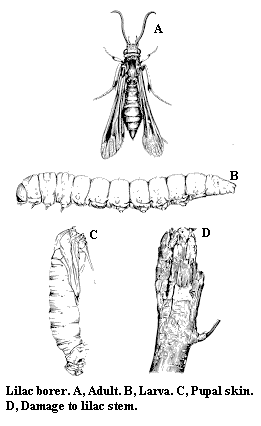Key to Lilac Pests
Southern nurserymen produce about 15,000 lilacs for sale each year. These shrubs have long been prized as landscape ornamentals. The name "lilac" is derived from the Sanskrit and Arabic words for indigo, nilak and lilak, respectively. Lilacs were once extensively forced into bloom in European greenhouses to provide fragrance and beauty for nobility during winter.
Common lilacs grow well in the Piedmont and Mountains; Persian lilacs grow better in the Coastal Plain.
- Lilac borer -Trunks and large limbs are marked by cracked bark and holes with protruding material resembling sawdust. Sometimes the leaves wilt on infested branches, or the branches break off easily.
Lilac Borer
Lilac borer, Podosesia syringae (Harris), Sesiidae, LEPIDOPTERA
DESCRIPTION
Adult – The adult lilac borer is a wasplike clearwing moth with brown forewings and transparent hind wings. The head, throax, and a portion of the abdomen are chestnut red with narrow, black margins. Males have featherlike (bipectinate) antannae; females have unmodified (filiform) antennae. The female's wingspread ranges from 32 mm to 38 mm; the male's, from 26 to 32 mm
Larva – The larva is a brown-headed, white caterpillar that can grow up to 25 mm long.
BIOLOGY
Distribution – Lilac borers are found throughout the eastern United States and Canada and as far west as west Texas and Colorado.
Host Plants – The lilac borer was first reported in 1839 on lilac. Ash, moutain ash, privet, and other trees in the olive family (Osmanthus, old man's beard) are also victims of the lilac borer.
Damage – Lilac borers tunne into the main stems, causing the plant to wilt during hot weather. Infested shrubs appear unhealthy, the stems breaking off rather easily. Infested areas appear swollen and cracked because the sapwood is also destroyed. Numerous holes are visible in heavily infested stock, and frass is usually abundant. Moreover, the wounds caused by the lilac borer allow a wood-destroying fungus, Polyporus vericolor, to enter, producing additional damage.
Life History – The adult lilac borer is a clearwing moth closely resembling a paper wasp in form and behavior. Adults emerge in August and September to mate, and the females lay their eggs on the rough bark or wounds of lilac and privet. As soon as they hatch, the tiny worms bore into the bark. Contact is maintained with the outside, and frass is expelled through the opening. Lilac borers overwinter as larvae in the wood, usually near the ground. The following spring and summer, the borers tunnel under the bark and into the wood. The larvae pupate close to the surface. There is one generation per year.
CONTROL
Heavily infested stems should be pruned out. Infestation-prone shrubs can be sprayed with a residual pesticide in August to prevent further infestation. In lightly infested stems, the borers may be destroyed by probing with a flexible wire. For specific chemical controls, see the current state extension recommendations.
Publication date: Jan. 1, 1993
AG-189
Other Publications in Insect and Related Pests of Shrubs
N.C. Cooperative Extension prohibits discrimination and harassment regardless of age, color, disability, family and marital status, gender identity, national origin, political beliefs, race, religion, sex (including pregnancy), sexual orientation and veteran status.

